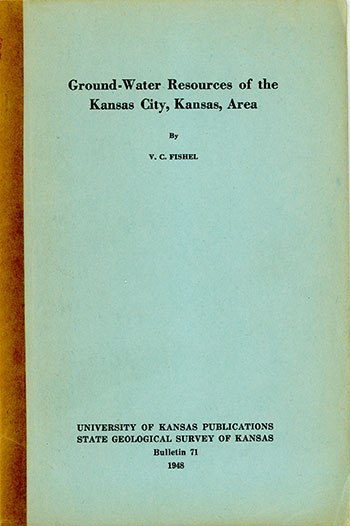Ground-water Resources of the Kansas City, Kansas, Area
by V. C. Fishel
with analyses by H. A. Stoltenberg

Originally published in 1948 as Kansas Geological Survey Bulletin 71. This is, in general, the original text as published. The information has not been updated. An Acrobat PDF version (16 MB) is also available; plate available separately.
Abstract
This report describes the ground-water resources in the industrial areas in the Missouri and Kansas River Valleys in Kansas City, Kansas, and the Kansas River Valley extending from Kansas City to Bonner Springs, Kansas. The part of the Missouri River Valley considered is known as the Fairfax Industrial District and comprises about 4 square miles. The Kansas River Valley area in Kansas City, Kansas, includes five industrial districts--the Woodswether, Central, Rosedale, Armourdale, and Argentine Districts. The five districts have a combined area of about 7 square miles. The climate is subhumid, the normal annual precipitation being 36.19 inches.
The bedrock underlying the part of the Missouri and Kansas River Valleys in the Kansas City area is in the Missourian Series of the Pennsylvanian System. The Missourian Series has a total thickness of about 600 feet and is characterized especially by prominence of numerous limestone beds separated by thin deposits of clayey to somewhat sandy shale. Broadly.speaking, these rocks do not yield water to wells at large rates, but they supply much of the ground water for farm wells on the upland in Wyandotte County.
The alluvium in the Kansas and Missouri River Valleys consists of streamlaid deposits, probably including glacial outwash, that range in texture from clay and silt to sand and very coarse gravel. The thickness of the alluvium in a cross section of the Missouri River Valley, as determined by 11 test holes, averages 95 feet and the valley at the cross section is 2.1 miles wide. The average thickness of the alluvium in five cross sections in the Kansas River Valley ranges from 51 feet in a cross section near Bonner Springs to 77 feet in a cross section on Central Avenue in Kansas City. The width of the Kansas River Valley at the cross sections ranges from 1.0 to 1.6 miles. The ground water in the alluvium consists largely of water that has fallen as rain or snow and has percolated through the soil and subsoil materials to the water table.
The water table in the Fairfax District is from about 6 to 15 feet below the land surface. In the East Armourdale and Central Districts the water table generally is about 20 to 36 feet below the land surface, but at a few local points of heavy pumping it is somewhat lower. In the West Armourdale and Argentine Districts it ranges from 12 to 27 feet below the land surface and in the valley west of Argentine it ranges from about 10 to 30 feet below the land surface.
Two pumping tests were made in the Fairfax District, one test by the Corps of Engineers in 1944 and another test by the Layne-Western Company in 1941. From the data obtained it was computed that the alluvium in the Fairfax District has a coefficient of permeability of about 3,000 gallons a day per square foot.
Most of the wells constructed in recent years are of the gravel-pack type and are about 16 inches in diameter. The yields of 51 wells and the drawdowns for most of these wells are given. Twenty-two of the wells are in the Missouri River Valley and have an average yield of 980 gallons a minute and an average specific capacity of 180 gallons a minute per foot. Twenty-nine of the wells are in the Kansas River Valley and have an average yield of 650 gallons a minute and an average specific capacity of 60.
The industrial use of ground water in the Kansas City, Kansas, area is almost entirely for cooling and condensing purposes. It amounts to about 35,000,000 gallons a day and includes about 17,400,000 gallons a day in the Fairfax District, about 10,300,000 gallons a day in the East Armourdale and Central Districts, about 6,600,000 gallons a day in the Argentine and West Armourdale Districts, and about 700,000 gallons a day in the Kansas River Valley west of Kansas City.
The ground water in the alluvium in the Missouri and Kansas River Valleys is very hard and contains large amounts of iron. Of 75 samples of water collected in the area all but 3 contained more than 2.0 parts per million of iron and most of the samples contained more than 5.0 parts. The samples of water from the Missouri River Valley and from the Kansas River Valley west of Kansas City contained less than 100 parts per million of chloride but the samples collected in the Argentine, Armourdale, and Central Districts contained much greater amounts of chloride; 13 samples contained more than 200 parts per million of chloride and 5 samples contained more than 1,000 parts.
The report contains a map of the area showing the locations of wells and test holes. Maps that include only the area within Kansas City show contours on the bedrock and the thickness of the saturated alluvium. The field data upon which most of this report is based are given, including records of 81 wells and 86 test holes and chemical analyses of the water from 75 wells and test holes. Logs of 126 test holes and wells are given, including 59 test holes put down by the State Geological Survey.
Kansas Geological Survey, Geohydrology
Placed on web Oct. 4, 2016; originally published February 1948.
Comments to webadmin@kgs.ku.edu
The URL for this page is http://www.kgs.ku.edu/Publications/Bulletins/71/index.html